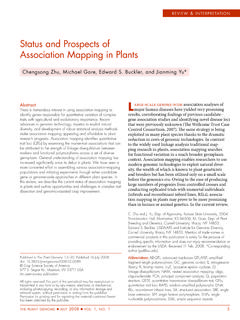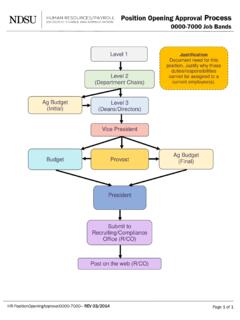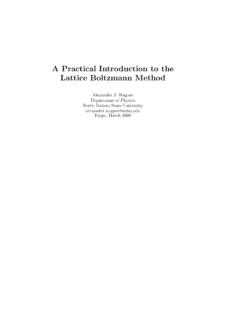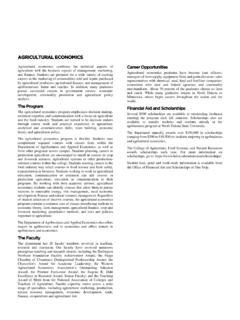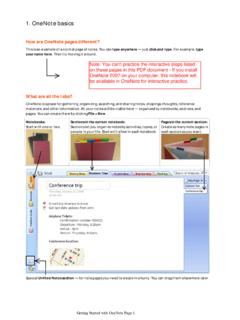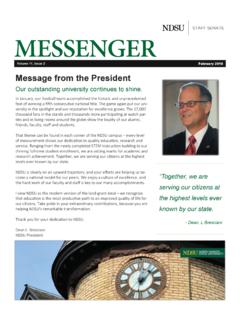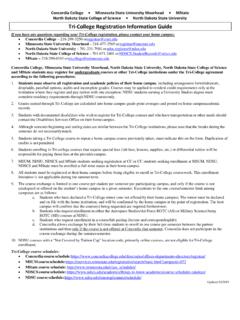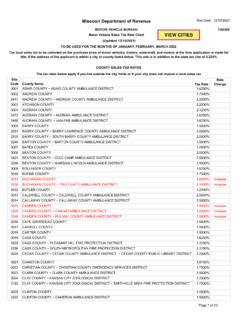Transcription of Saline and Sodic Soils - North Dakota State University
1 Background:The wet climate during the last 20 years has increased salinity acres. As per a recently published report there are nearly million acres in North Dakota which are affected by soil salinity (Brennan, J., and M. Ulmer, 2010, Salinity in the Northern Great Plains, Natural Resources Conservation Service, Bismarck, ). With more acres affected each year by salinity and sodicity, the management and alleviation of Saline and Sodic Soils cannot be stressed more. Even though closely related and having many characteristics in common, soil salinity and sodicity are two different problems, which should be dealt with differently and require slightly different management practices. This publication is intended to help the farm producer or landowner to understand the fundamental differences between these two between Saline and Sodic Soils : Saline soil is a term used to describe excessive levels of soluble salts in the soil water (soil solution), high enough to negatively affect plant growth, resulting in reduced crop yields and even plant death under severe conditions (Figure 1).
2 Figure 1. A typical Saline spot along State Highway 17 East, primary effect of excessive soluble salts on plants is to limit the ability of plant roots to absorb soil water even XQGHU ZHW VRLO FRQGLWLRQV 6 RLO ZDWHU RZV IURP KLJKHU RVPRWLF SRWHQWLDO ORZ VDOW FRQFHQWUDWLRQ WR ORZHU RVPRWLF potential (high salt concentration). A soil solution with low osmotic potential due to the higher concentration of VROXEOH VDOWV FRPSDUHG WR WKH SODQW FHOOV ZLOO QRW DOORZ SODQW URRWV WR H[WUDFW ZDWHU IURP VRLO JXUH FDXVLQJ drought-like symptoms in the plants (Seelig, 2000). That process is called osmotic effect . Saline and Sodic SoilsNDSUEXTENSIONSERVICEF igure 2. Excessive soluble salts causing drought-like symptoms in most common soluable salts in North Dakota Soils are sulfates of sodium, calcium and magnesium (Keller et al., 1984). However, Saline Soils in the northern Red River Valley have high amounts of chlorides of sodium, calcium and magnesium (Seelig, 2000). The third most common group of salts is carbonate based.]
3 As the word soluble indicates, these salts can easily be leached out of the upper 2-3 feet of surface soil under good soil moisture and drainage contrast to Saline Soils , Sodic Soils have excessive levels of sodium (Na+) adsorbed at the cation exchange sites (Figure 3). Soil sodicity causes degradation of soil structure. That process is called soil dispersion. Figure 3. Example of a Sodic soil aggregate with more than 15 percent of itscation exchange sites occupied by sodium ions. The forces that hold clay particles together are greatly weakened when excessive sodium is adsorbed at the negative charges of clay particles, forming sodium-clay particles (Seelig, 2000). When wet, sodium-clay particles get easily disintegrated or dispersed from the larger soil aggregates (Figure 4). Once dry, sodium-clay particles clog the soil pores (especially macro-pores) and settle down in dense layers (Figure 5). NDSUEXTENSIONSERVICEF igure 4. Degrees of soil dispersion due to soil sodicity through the disintegration of soil particles(Photo courtesy of Alison Lacey, Copyright Western Australian Agriculture Authority, 2009).
4 3 RRU SK\VLFDO VWUXFWXUH JXUH WKHQ UHVXOWV LQ VRLOV GLI FXOW WR WLOO SRRU VHHG JHUPLQDWLRQ DQG UHVWULFWHG SODQW root growth. Due to the poor physical structure, Sodic Soils are also susceptible to wind and water erosion compared to Saline Soils . Soil dispersion effect will be more severe on expanding-type of clays as their degree of swelling increases, causing the clogging of the larger soil pores. In Saline and Saline - Sodic Soils though, KLJKHU FRQFHQWUDWLRQV RI VDOWV SURYLGH H[FHVV FDWLRQV OLNH FDOFLXP DQG PDJQHVLXP ZKLFK SURPRWH RFFXODWLRQ (opposite of dispersion) by moving in close to the negatively charged particles, thereby reducing their tendency to disintegrate or disperse from each other (The Nature and Properties of Soils , 14th Edition, Revised).Figure 5. Soil with good physical structure (left) versus a dispersed soil with poor physical structure on the Causes:The causes for Saline and Sodic Soils in the northern Great Plains are natural, but both conditions can be affected by management.]
5 The primary natural cause for these two is the parent material of the Soils within the State and the underlying sodium-rich shale that is present in the bedrock below the soil sediments. NDSUEXTENSIONSERVICEThe severity of soil salinity or sodicity occurs where there is shallow Saline or Sodic groundwater level (Figure *URXQGZDWHU OHYHOV LQ UHODWLRQ WR WKH VRLO VXUIDFH XFWXDWH GHSHQGLQJ XSRQ WKH SUHFLSLWDWLRQ UHFHLYHG DQG WKH evapotranspiration of the vegetative cover. Groundwater levels that average about 6 feet or less in depth are highly susceptible to salinity or sodicity development (Seelig, 2000). Groundwater within 6 feet of the surface can move through capillary action to or near the soil surface resulting in very low or no downward movement of excessive soil water and soluble salts, very low soil oxygen content along with bringing in salts with it. The water evaporates, leaving behind the salts. The longer the groundwater level is close to the surface, the greater level of salts or sodium will develop.)
6 In rolling topography, with soil texture discontinuity or hard layers, such as coal seams, Saline seeps can develop during periods of high rainfall. Figure 6. A well-drained soil with low groundwater level (left) versus a saturated soilwith very shallow groundwater level on the major reason for bringing in excessive salts in the plant root zone is the use of excessive irrigation water or having very wet weather conditions (excessive rains), which are man-made and natural respectively. In North Dakota though, predominantly it is the wet cycle which creates ideal conditions for shallow groundwater level, thus causing soil salinity and :In Soils suspected as being Saline or affected by sodium, the extent of the problem and its management are GLI FXOW WR GHWHUPLQH XQOHVV WKH VRLO LV DQDO\]HG XVLQJ ODERUDWRU\ SURFHGXUHV 6 RLOV VKRXOG EH VDPSOHG WR DW OHDVW 2 feet depth in 6-inch increments. Soil salinity can be diagnosed by measuring the salt concentration in soil water (solution) by analyzing it for Electrical Conductivity (EC).
7 EC is the ability of a material to transmit electrical current, which in the case of a soil is the result of salt +H1+Ca2+Mg2+Na1+K1+NO3-H2PO42-Cl1-MgCl2 CaCl2 NaClCa2+Mg2+MgCl2 CaCl2 NaClNa1+H1+Ca2+Mg2+Na1+K1+NO3-H2PO42-Cl1 -MgCl2 CaCl2 NaClCa2+H1+K1+NO3-H2PO42-NaClNaClMgCl2 MgCl2 CaCl2 CaCl2Ca2+Ca2+Mg2+Mg2+Na1+Na1+Mg2+)LJXUH ([DPSOH RI D HOG GLWFK DORQJ VWDWH +LJKZD\ 1 ' $ VRLO LV FODVVLILHG DV VDOLQH RQFH LWV VDWXUDWHG SDVWH H[WUDFW (& ZLOO UHDFK GHFL6 LHPHQV PHWHU G6 P ZKLFK ZLOO EH HTXDO WR PLOOLPKRV FHQWLPHWHU PPKRV FP XVLQJ WKH VDPH VDWXUDWHG SDVWH H[WUDFW PHWKRG (& values measured through 1:1 by weight Voil-to-water slurry method are less precise and will result in lower values versus the saturated paste extract method. Variation among the EC values measured through these two methods will also differ for different soil textures. Following formulas in Table 1, can be used as a rough guide for the conversion of EC = EC of saturated paste extracty = EC of 1:1 soil:water slurrySoil Texture Coarse Medium FineX = X = X = = + y = + y = + Saline Soils in North Dakota , Revised, David Franzen, extent of soil sodicity is measured either through its Exchangeable Sodium Percentage (ESP) or Sodium Adsorption Ratio (SAR).))]]]
8 Both measure the sodium content of the Soils in relation to calcium and magnesium XVLQJ VSHFL F PDWKHPDWLFDO IRUPXODV 6 RGLF VRLOV DUH ORZ LQ WRWDO VROXEOH VDOWV EXW KLJK LQ H[FKDQJHDEOH VRGLXP which tends to disperse soil particles and destroys soil structure (Management of Saline and Sodic Soils , Kansas State University , 1992). A soil will be interpreted as Sodic if it has an Exchangeable Sodium Percentage of 15 or more or have Sodium Adsorption Ratio of 13 or more. Sodic Soils often have a pH level of or more in carbonate-rich Soils , such as in northeastern North Dakota , but may also have very low pH, perhaps as low as in southeastern North Dakota in Soils with no carbonates. Soils having both, salinity as well sodicity problems are considered as Saline - Sodic Soils and will have the characteristics of both. Typical characteristics of Saline , Sodic and Saline - Sodic Soils are presented in Table FDWLRQ (OHFWULFDO &RQGXFWLYLW\ 6 RLO S+ ([FKDQJHDEOH 6 RGLXP $GVRUSWLRQ 6 RLO 3K\VLFDO PPRKV FP 6 RGLXP 5 DWLR &RQGLWLRQ Saline > < < 15 < 13 NormalSodic < > > 15 > 13 PoorSaline- Sodic > < > 15 > 13 Normal= greater than, < = less thanManagement of Saline and Sodic Soils , Kansas State University , of Saline Soils :Because salts can only be leached downward in the Soils with soil water, attention to drainage is very important.))]]
9 Assessment of where the water comes from that result in the high water table is particularly important. 0 DQDJHPHQW PLJKW UVW EH EDVHG RQ LQWHUFHSWLQJ ZDWHU FRPLQJ LQWR WKH SUREOHP DUHD ZLWK PLWLJDWLRQ RI WKH DFWXDO VDOLQLW\ DV D VHFRQGDU\ VWHS ,PSURYHG XVH RI LQ HOG DQG ERXQGDU\ HOG GLWFKHV FDQ DOVR LPSURYH VRLO GUDLQDJH DQG IDFLOLWDWH OHDFKLQJ RI VDOWV JXUH NDSUEXTENSIONSERVICET able 1. General conversion from 1:1 soil:water slurry method used by many commercial labs and the saturated paste extract method used in research applications.'UDLQDJH PLJKW LQYROYH SODQWLQJ RI ZDWHU XVH HI FLHQW FURSV LQWHUFHSWLQJ FURSSLQJ ZLWK FURSV OLNH DOIDOID WR XVH water before it enters the problematic area, use of cover crops in non-crop intervals or the installation of surface RU VXEVXUIDFH GUDLQDJH V\VWHPV OLNH WLOH GUDLQDJH JXUH Figure 8. Installation of tile drainage in progress in Ramsey County along State Highway 17 near Edmore, (Photo courtesy of Ronald Beneda, NDSU Cavalier County Extension agent).
10 A thorough analysis of EC and SAR or ESP should be conducted before the installation of any subsurface drainage system, as excessive leaching of divalent cations (calcium and magnesium) can lead to the sealing of soil layers either around or above the tiles, if placed within or under the Sodic layers. :LWK LPSURYHG VRLO SHUPHDELOLW\ DQG LQ OWUDWLRQ DFKLHYHG WKURXJK GUDLQDJH XQGHU JRRG VRLO PRLVWXUH FRQGLWLRQV (rainfall or irrigation) desired results should be achieved through the continuous leaching of soluble the absence of good soil drainage in place combined with a high groundwater levels, late-maturing, deep-URRWHG DQG VDOW WROHUDQW FURSV OLNH DOIDOID VXJDUEHHW DQG VXQ RZHU FDQ DOVR EH H[FHOOHQW FKRLFHV ZKLFK ZLWKVWDQG moderate salt levels and take water from deeper depths (Franzen, 2007). To avoid excessive recharge of groundwater levels through rain along with reducing the soil surface evaporation, continuous cropping can also be very of Sodic Soils :,Q RUGHU WR UHFODLP VRGLF VRLOV LW LV HVVHQWLDO WR UVW UHSODFH WKH H[FHVVLYH VRGLXP IURP WKH FDWLRQ H[FKDQJH sites with large amounts of calcium supplements before starting the salt leaching process.]]]


